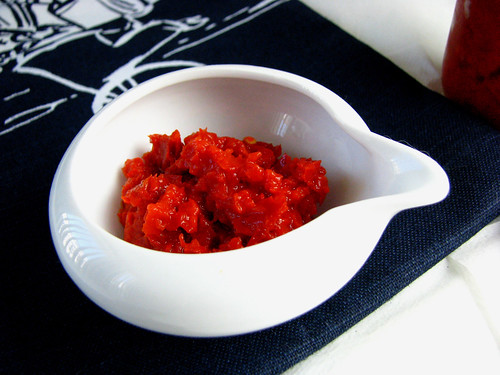Sambal can be define as a chili based sauce, which is made by either sauteing blended chili or just consumed fresh by pounding it to a paste in a mortar. There are various variety of sambal, from the fried to the fresh.
Commonly, in Malaysia the most famous sambal of all is the sambal belacan, which is literally chili paste with fermented dried shrimp powder. This type of sambal is usually a freshly pounded condiment that is served with rice or raw vegetables. The paste is usually a mix of red chili, small green chili, dried shrimp powder and sometimes the use of fresh lime juice or tomatoes. You can also just use green chili which is more heaty to the tongue in comparison to using red chili. If you live in say the US or Europe, am sure chili is not as easy to find as it is here in Malaysia, unless you live closer to South America. To help you find out what chili is best to use when you aren't in Asia, here I have a link to a blog I came across, highoverhappy while reading on sambal in foreign countries. The author lives in California and shares her recipe of making sambal and utilising other types of chili with in her area.
To get that salty and rounded flavour in the sambal, it is common to add dried shrimp powder or freshly grounded, into the paste. However, using salted mackerel fish or perhaps any other salted fish you may have in your markets - makes the paste a little more better to the taste compared to the bitterness that's contributed by dried shrimp.
Chili unlike bell peppers, has not much of a taste to it. Its basically just plain - HOT. To make the chili stand out better, adding ingredients with a bit of sweetness to it would do you wonders. Hence, the use of shallots are highly recommended. Garlic is gives a rather bitter and pungent flavour when raw, so if you are pounding your sambal fresh for consumption, I would avoid adding garlic into the mortar.
Fruits are also sometimes added to this condiment that is usually served as an appetiser that is either dipped with raw vegetables or consume with hot steamy rice. Pairing sambal with cherry tomatoes, unripened mango or star fruit, gives it a sour taste that compliments the sweetness of the sugar content. If you do not love durian, then I guess this next tip is not meant for you...but, tempoyak or fermented durian is not so bad as you think it is. When durian is fermented, it is usually blended with either salt or sugar. For the sambal - the sweeter tempoyak is used. This concoction might seem off putting, but trust me, the kick of heat from the chili and the creaminess from the durian, just balances out. Very good with fresh raw vegetables like basil, ulam raja, cucumber and aubergine.
 |
| Photo Credit to highoverhappy.blogspot.com |
Sambal Oelek is a Javanese style chili paste that refers not to the ingredients or the chili paste, but rather to the mortar and pestle that is used to make the paste. The main ingredients are basically the same, only difference is that the ingredients in sambal oelek are usually sautéd with a bit of hot oil, till all the ingredients are soft and aromatic. Some recipes would require you to add vinegar to the mix but you can omit the vinegar and substitute it with lime if you can't take the acidity. Before serving, a tablespoon of coconut oil is added to the pounded paste to give it a creamier and glistening ending. This type of sambal is also the same paste you would see in Nasi Padang stalls, drenched onto fried cat-fish, daging dinding and hardboiled eggs.
 |
| Photo Credit to emotypo.wordpress.com |
Sambal Tumis is another version in the sambal family. However, for this sambal, the chili used here is the dried chili. The process of making this sambal is a bit more tedious but worth all the effort. First, the seeds of the chili are discarded, the chili is then boiled in hot water a couple of times to make the chili a bit more mild and not too hot. It is then blended and fried in the wok till the colour changes from bright to a darker shade of red, like you see in the photo above. Here is a relink to a previous post on how to prepare the paste for sambal tumis, click here.
This type of sambal is the one you commonly see served with nasi lemak, dhal and served as a dish at economical rice stalls. The sambal tumis is a versatile option compared to the other two because you can make a dish just with the chili paste, by adding prawns or squid or chicken to it. It is versatile because you can add various other ingredients such as lemongrass, tumeric, ginger, galangal to this paste to make rendang, masak merah, terutub and loads more local Malaysian dishes.
So, the next time you drop in to C.I.B., you be sure to catch up with the latest postcard editions. As we will be hooking you up with a series of sambal paste and everything that pairs with it. If you have a version of your own sambal, leave a comment and share your type of sambal with us.
xx
xx
C.I.B.


No comments:
Post a Comment
Thanks for reading our blog, we would love to hear from you and keep track to who's been checking us out. Leave a comment, share your kitchen tips and recipes. We look forward to hear from you.
xx
C.I.B.